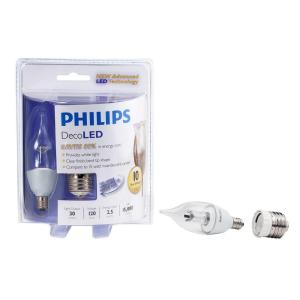LED Me Tell You About My Light-er Electric Bill
In an earlier post, I showed how a new energy-efficient refrigerator was saving me hundreds of dollars per year. This post will highlight how a set of LED bulbs with a high initial price tag will not take too long to pay for themselves and then will begin to save me money.
Several years ago I switched almost every light bulb inside and outside the house with CFL bulbs. One exception: the six-bulb candelabra in the dining room still had the old incandescent flame tip bulbs that used more energy and threw off more heat. This is the room where we work on our laptops and where we entertain guests. The other candelabras in the house had CFLs that were covered by a piece of glass that hid the twisted bulb inside but they were not appropriate for an exposed fixture in plain view of guests. (I am being polite. The shape of these covered bulbs is, well, I imagine something one might find in an adult shop.)
For years I looked at that candelabra and knew it was wasting energy and heating up the room. We use this fixture more than any other light in the house so I wondered if there were LED bulbs in the shape of bent tip flames. Home Depot had them for almost $11 per bulb after tax which appeared to be a very expensive switch. However, after working out the math, buying these bulbs ended up being a no-brainer.

Philips Decorative LED Bulb
According to Philips, these bulbs will last 18.3 years if used an average of three hours per day. (Home Depot will replace them for life so there is no risk!) Based on three hours per day at my current LIPA rate of $0.17 kWh, each bulb will save me $44.20 over that 18.3 year lifetime. At $11 per bulb, the energy savings will pay for the bulbs in about 4.5 years. (Of course, the assumption is that energy rates will not rise in the next 4.5 years. I assume that the rates will rise and I will achieve my cost savings sooner.) As an added bonus, these bulbs cast off almost no heat which is a huge improvement over the older bulbs that quickly heat up the dining room to uncomfortable levels in the warmer seasons.
Another example of how we can save the planet and save money at the same time.


I have to admit that as much as I like to see the energy savings, I like how the wastefulness of traditional bulbs encourages people to turn them off at night. I fear the LEDs will make it so cheap to spill light everywhere and at all hours, that I’ll rarely enjoy a dark sky or a dark neighborhood for sleeping. The idea of aiming light rather than scattering it in all directions gets overlooked in building construction, home improvement and even in LEED certification (http://palomarskies.blogspot.com/search?q=LEED+certified). My County is working on a light-trespass ordinance. I guess I’ll need to give them a kick so as to be ready for the new LEDs.
jg
jg
August 1, 2011 at 11:39 am
jg – one advantage LEDs have is that they’re highly directional with their light output. If you want broad spill lighting, you have to design the bulbs/fittings to specifically spread out the light from the LEDs, unlike incandescant or even CFL lighting, where the light radiates in all directions and bulbs/fittings must be designed to constrain the light output.
So in that regard, there’s potential for LEDs to be even *more* efficient – by wasting less of the light output. We replaced 200w worth of halogen lights in our kitchen with 36w of LED lighting. No, it’s not as well lit as it was – the upper walls & ceilings aren’t as well illuminated, for example. But the workbenches are, and I’d argue that’s quite good enough!
Unfortunately, the lights were quite expensive (LEDs had only just started appearing on the market here), but even with that, the difference in electricity use is enough to pay them off in just 5-6 years (which means that we’re half-way to having paid for them already!)
I can now buy similar LED lights for about a quarter of the price. Might have to pick up a few more…
Bern
September 3, 2011 at 6:18 am
[…] my blog post titled LED Me Tell You About My Light-er Electric Bill, I showed how using LED bulbs in the most used light fixtures can save money even though the […]
It is Easy to Save Money and Our Planet at the Same Time « Global Warming: Man or Myth?
June 4, 2012 at 10:15 am
[…] Originally published on Global Warming: Man or Myth by Scott Mandia […]
LED Me Tell You About My Light-er Electric Bill | CleanTechnica
November 11, 2013 at 10:32 am
[…] Originally published on Global Warming: Man or Myth by Scott Mandia […]
LED Me Tell You About My Light-er Electric Bill | OzHouse
November 11, 2013 at 11:12 am